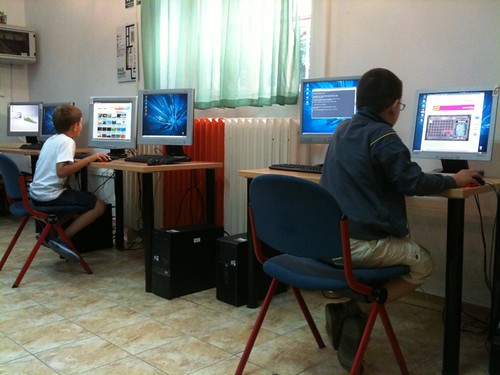Fedora in Public Libraries

Our local Linux Users Group in my home town of Osijek has started workshops called knowledge exchange in partnership with our public library. So first step was to install Fusion Linux Fedora Remix on their PCs.
Are there other examples with Fedora being rolled out in public libraries or in some other public institutions? I would be really interested with their experiences.
In my example there are 6 PCs that are used by any member of library, usually those are primary and high school kids. They come here and most of their activities are watching youtube, logging onto facebook and playing flash games.
Their primary OS is Windows XP with Windows SteadyState enabled. I found out that they decided to use Windows SteadyState because they had problem monitoring kids and they would leave p2p apps running and downloading music and video files and come back a day later with hard drives to save them onto. Obviously that is not what they want kids to do so by enabling Windows SteadyState any files downloaded are erased by reboot. This policy probably also removes most virus issues, both because kids don't plug any usb devices and because any changes are erased.
First issue I came across was that Anaconda installed and GParted wouldn't resize single windows ntfs partition because there were some errors on hard drive. I tried logging into Administrator account and running chkdsk /f but that didn't help, even with option that Windows SteadyState merges changes. I didn't want to disable Windows SteadyState so I reverted to boooting of Windows live CD and running chkdsk /f from repair console. That fixed the issues on all machines.
I didn't have good experience with Anaconda ntfs resize so I used GParted to resize ntfs partitions. GParted worked perfectly on all machines without issues.
After installing Fusion Linux I did these post install tweaks:
- Change grub entry "Windows XP" from "other"
- Change grub entry to Fusion Linux 14 from Fusion Linux 14.1 (2.6.35.13-92.fc14.i686)
- Put 10 seconds wait in grub menu
- Enable automatic login
- Disble screensave password lock
- Enable automatic updates
- Put Firefox, Chromium and Teeworlds icons on desktop
What would be best way to enable "Windows SteadyState" equivalent in Fedora? Brute force way would be a simple script that deletes all files in user home folder. Are there some more subtle ways? And how to make some changes permanent while making all other changes transient? Using unionfs seams like a bit of a overkill... Any suggestions are welcome.


